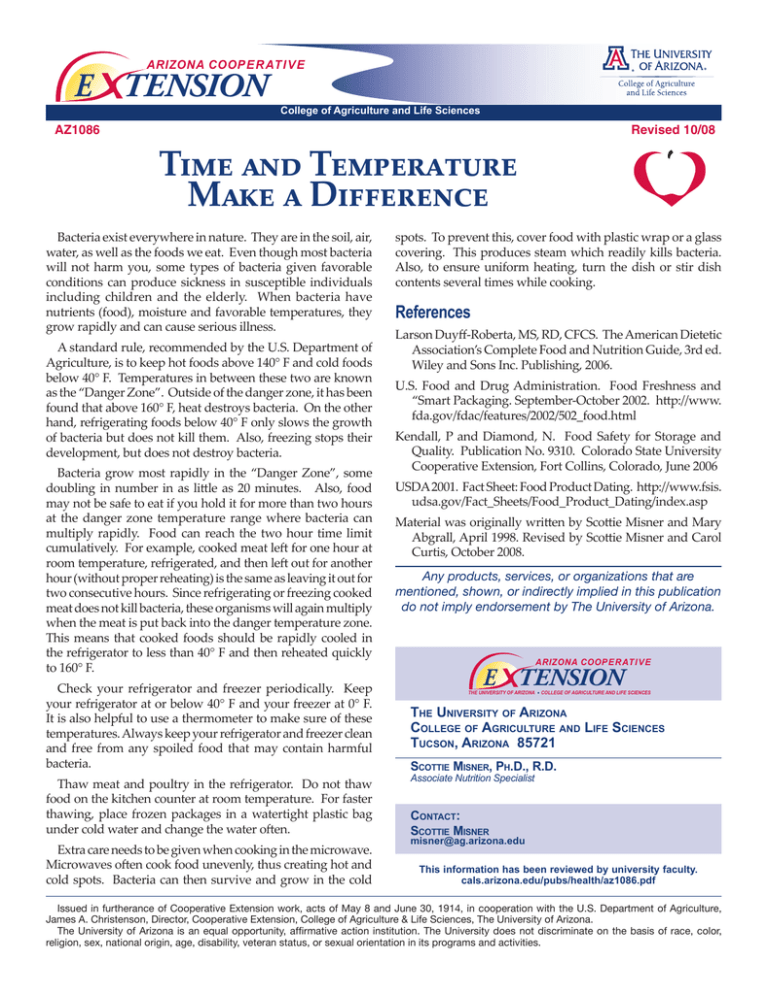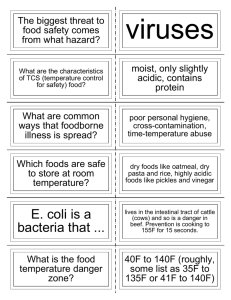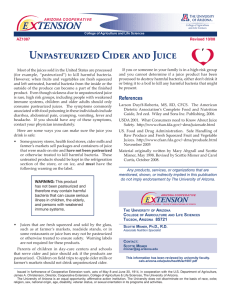Time and Temperature Make a Difference E TENSION
advertisement

ARIZONA COOP E R AT I V E E TENSION College of Agriculture and Life Sciences AZ1086 Revised 10/08 Time and Temperature Make a Difference Bacteria exist everywhere in nature. They are in the soil, air, water, as well as the foods we eat. Even though most bacteria will not harm you, some types of bacteria given favorable conditions can produce sickness in susceptible individuals including children and the elderly. When bacteria have nutrients (food), moisture and favorable temperatures, they grow rapidly and can cause serious illness. A standard rule, recommended by the U.S. Department of Agriculture, is to keep hot foods above 140° F and cold foods below 40° F. Temperatures in between these two are known as the “Danger Zone”. Outside of the danger zone, it has been found that above 160° F, heat destroys bacteria. On the other hand, refrigerating foods below 40° F only slows the growth of bacteria but does not kill them. Also, freezing stops their development, but does not destroy bacteria. Bacteria grow most rapidly in the “Danger Zone”, some doubling in number in as little as 20 minutes. Also, food may not be safe to eat if you hold it for more than two hours at the danger zone temperature range where bacteria can multiply rapidly. Food can reach the two hour time limit cumulatively. For example, cooked meat left for one hour at room temperature, refrigerated, and then left out for another hour (without proper reheating) is the same as leaving it out for two consecutive hours. Since refrigerating or freezing cooked meat does not kill bacteria, these organisms will again multiply when the meat is put back into the danger temperature zone. This means that cooked foods should be rapidly cooled in the refrigerator to less than 40° F and then reheated quickly to 160° F. Check your refrigerator and freezer periodically. Keep your refrigerator at or below 40° F and your freezer at 0° F. It is also helpful to use a thermometer to make sure of these temperatures. Always keep your refrigerator and freezer clean and free from any spoiled food that may contain harmful bacteria. Thaw meat and poultry in the refrigerator. Do not thaw food on the kitchen counter at room temperature. For faster thawing, place frozen packages in a watertight plastic bag under cold water and change the water often. Extra care needs to be given when cooking in the microwave. Microwaves often cook food unevenly, thus creating hot and cold spots. Bacteria can then survive and grow in the cold spots. To prevent this, cover food with plastic wrap or a glass covering. This produces steam which readily kills bacteria. Also, to ensure uniform heating, turn the dish or stir dish contents several times while cooking. References Larson Duyff-Roberta, MS, RD, CFCS. The American Dietetic Association’s Complete Food and Nutrition Guide, 3rd ed. Wiley and Sons Inc. Publishing, 2006. U.S. Food and Drug Administration. Food Freshness and “Smart Packaging. September-October 2002. http://www. fda.gov/fdac/features/2002/502_food.html Kendall, P and Diamond, N. Food Safety for Storage and Quality. Publication No. 9310. Colorado State University Cooperative Extension, Fort Collins, Colorado, June 2006 USDA 2001. Fact Sheet: Food Product Dating. http://www.fsis. udsa.gov/Fact_Sheets/Food_Product_Dating/index.asp Material was originally written by Scottie Misner and Mary Abgrall, April 1998. Revised by Scottie Misner and Carol Curtis, October 2008. Any products, services, or organizations that are mentioned, shown, or indirectly implied in this publication do not imply endorsement by The University of Arizona. ARIZONA COOP E R AT I V E E TENSION THE UNIVERSITY OF ARIZONA COLLEGE OF AGRICULTURE AND LIFE SCIENCES The University of Arizona College of Agriculture and Life Sciences Tucson, Arizona 85721 Scottie Misner, Ph.D., R.D. Associate Nutrition Specialist Contact: Scottie Misner misner@ag.arizona.edu This information has been reviewed by university faculty. cals.arizona.edu/pubs/health/az1086.pdf Issued in furtherance of Cooperative Extension work, acts of May 8 and June 30, 1914, in cooperation with the U.S. Department of Agriculture, James A. Christenson, Director, Cooperative Extension, College of Agriculture & Life Sciences, The University of Arizona. The University of Arizona is an equal opportunity, affirmative action institution. The University does not discriminate on the basis of race, color, religion, sex, national origin, age, disability, veteran status, or sexual orientation in its programs and activities.




